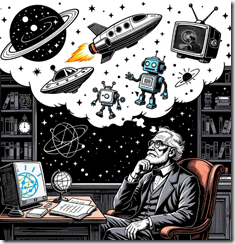IBM on the Path to Dyson Spheres But Quantum Networks Come First
November 28, 2025
 This essay is the work of a dumb dinobaby. No smart software required.
This essay is the work of a dumb dinobaby. No smart software required.
How does one of the former innovators in Fear, Uncertainty, and Doubt respond to the rare atmosphere of smart software? The answer, in my opinion, appears in “IBM, Cisco Outline Plans for Networks of Quantum Computers by Early 2030s.” My prediction was wrong about IBM. I thought that with a platform like Watson, IBM would aim directly at Freeman Dyson’s sphere. The idea is to build a sphere in space to gather energy and power advanced computing systems. Well, one can’t get to the Dyson sphere without a network of quantum computers. And the sooner the better.

A big thinker conceptualizes inventions anticipated by science fiction writers. The expert believes that if he thinks it, that “it” will become real. Sure, but usually more than a couple of years are needed for really big projects like affordable quantum computers linked via quantum networks. Thanks, Venice.ai. Good enough.
The write up from the “trust” outfit Thomson Reuters says:
IBM and Cisco Systems … said they plan to link quantum computers over long distances, with the goal of demonstrating the concept is workable by the end of 2030. The move could pave the way for a quantum internet, though executives at the two companies cautioned that the networks would require technologies that do not currently exist and will have to be developed with the help of universities and federal laboratories.
Imagine artificial general intelligence is like to arrive about the same time. IBM has Watson. Does this mean that Watson can run on quantum computers. Those can solve the engineering challenges of the Dyson sphere. IBM can then solve the world’s energy requirements. This sequence seems like a reasonable tactical plan.
The write up points out that building a quantum network poses a few engineering problems. I noted this statement in the news report:
The challenge begins with a problem: Quantum computers like IBM’s sit in massive cryogenic tanks that get so cold that atoms barely move. To get information out of them, IBM has to figure out how to transform information in stationary “qubits” – the fundamental unit of information in a quantum computer – into what Jay Gambetta, director of IBM Research and an IBM fellow, told Reuters are “flying” qubits that travel as microwaves. But those flying microwave qubits will have to be turned into optical signals that can travel between Cisco switches on fiber-optic cables. The technology for that transformation – called a microwave-optical transducer – will have to be developed with the help of groups like the Superconducting Quantum Materials and Systems Center, led by the Fermi National Accelerator Laboratory near Chicago, among others.
Trivial compared to the Dyson sphere confection. It is now sundown for year 2025. IBM and its partner target being operational in 2029. That works out to 24 months. Call it 36 just to add a margin of error.
Several observations:
- IBM and its partner Cisco Systems are staking out their claims to the future of computing
- Compared to the Dyson sphere idea, quantum computers networked together to provide the plumbing for an Internet that makes Jack Dorsey’s Web 5 vision seem like something from a Paleolithic sketch on the wall of the Lescaux Caves.
- Watson and IBM’s other advanced AI technologies probably assisted the IBM marketing professionals with publicizing Big Blue’s latest idea for moving beyond the fog of smart software.
Net net: The spirit of avid science fiction devotees is effervescing. Does the idea of a network of quantum computers tickle your nose or your fancy? I have marked my calendar.
Stephen E Arnold, November 28, 2025
Comments
Got something to say?


